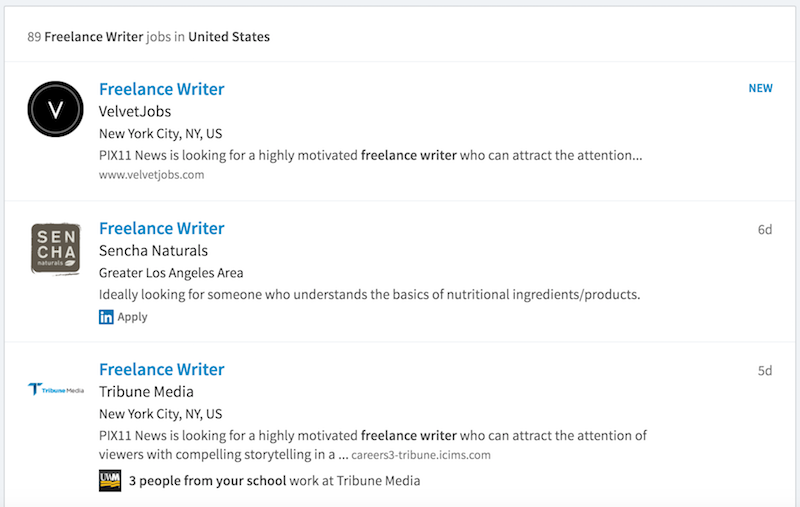Finding Freelance Writing Jobs: Where to Look and How to Land Them
Oct 24, 2016
Post updated: December 4, 2020

Your freelance website is up and running. You have a few published samples under your belt that you’re eager to share with prospective clients. You’re excited to finally sit down at your brand new workspace and get rolling on some projects and freelance writing jobs.
But, there’s only one problem: Uhhh… you don’t actually have anything to work on.
Oh, yes. “How the heck do you find work?” is a question I’ve heard echoed from pretty much every new freelance writer who has reached out to me.
And, believe me, I get it. I was paddling that same boat for months. I had everything I needed to get started—except for, ahem, any actual clients or work.
I won’t sugarcoat it: Finding freelance writing jobs (particularly when you’re just getting started!) can be tough. But, with all of the tools, resources, and platforms available today, it’s definitely doable.
So, now you’re left with one big question: How exactly do you do it? Wishing and hoping won’t do the trick, my friends. Let’s dig into some of my favorite, tried and true ways to find freelance writing work.
1. Peruse Job Boards
Let’s start with the most obvious option first, shall we? There are plenty of online job boards that list remote freelance jobs for all sorts of creative professionals—writers included. And, I’ll admit that when I was just getting my freelance career rolling, I relied on job boards shamelessly.
There are tons of them out there, but a few of my favorites are:
- FreelanceWriting.com
- Ed2010
- ProBlogger
- Hubstaff Talent
- We Work Remotely (lists full-time roles, but also freelance gigs)
- LinkedIn (which we’ll talk more about below)
RELATED: My Favorite Places to Find Freelance Gigs
How to Successfully Use Job Boards to Land Freelance Writing Jobs
These platforms are great for bringing you all sorts of different opportunities in a super convenient, easy-to-use way. But, guess what… everybody thinks that. There’s going to be a lot of competition applying for those very same open projects.
First things first, it’s important that you follow the application instructions.
If they want a certain number of writing samples, include exactly that many. If they want you to use a specific contact email address to submit your materials, do so. If they want you to stand on your head and sing “Sweet Caroline” at the top of your lungs, you’re going to have to do so (full disclosure: Nobody has ever actually asked me to do that, but now I sort of wish they would).
If you can’t follow basic instructions, you’ll have a tough time staying out of the dreaded “Junk” email folder.
After that? Well, follow-up is key when you’re dealing with the sea of competition that flocks to these online job boards. Put on your detective hat and do some digging to see if you can find a specific person (my favorite place to search is LinkedIn, by finding the company page and then looking through the employees) to check in with.
Of course, you don’t want to cross the line and be obnoxious. But, sending a personalized and friendly follow-up message after a reasonable amount of time is a great way to demonstrate your interest in the opportunity and your engagement in what the company is doing.

2. Search LinkedIn
I’ve sung the praises of LinkedIn time and time again. But, honestly, it deserves all of the ranting and raving. Hands down, it’s been one of my best secret weapons for growing my freelance business.
Spoiler alert: There’s a lot of junk on LinkedIn. But, if you’re willing to filter through the noise, you can find some golden nuggets.
I just touched on how I cyberstalk (it’s strictly professional, of course) companies in order to find a personalized contact. But, using the LinkedIn “Jobs” page can also be a great asset to you.
Head to your LinkedIn page and then click the “Jobs” link in the top navigation bar. That will bring you to a screen that looks like this at the top:

If there’s automatically a location entered in the “location” field (thanks, pesky GPS robots), make sure you delete that out. Freelance gigs often aren’t limited by location, so there’s no point in narrowing your search using that criteria.
Then, in the search box, enter a keyword that fits what you’re looking for. As a freelance writer, some of my favorite search terms include:
- Freelance Writer
- Freelance Blogger
- Freelance Content Creator
…you get it.
I always make sure to use “freelance” in the search phrase, so I’m not being lured in by a bunch of full-time offers. Press search, and you’ll be met with pages of results that you can apply for:

How to Successfully Use LinkedIn to Land Freelance Writing Jobs
Remember those rules and tips we just discussed about successfully using job boards? Well, since LinkedIn is still essentially a job board in this regard, all of those still apply.
However, I’ll add one more to the mix: Ensure that you polish up your LinkedIn profile before applying for any jobs using this platform. After all, that’ll likely be the first place people look when they receive your materials. So, you want it to make the right impression.
RELATED: Step Up Your LinkedIn Presence With These 7 Quick Things
3. Send Cold Emails (Yes, Seriously)
This last point is the one that has yielded the most success and the highest amount of projects in my freelance career.
I think that’s for two reasons: It takes initiative on your end and it’s a proactive approach—it explains to brands or outlets why they need you, rather than you waiting for them to post an open position or opportunity.
So, how exactly does this work? Well, it’s surprisingly simple.
Let’s say I’m a freelance writer with a niche of pet and animal-related content. Through my research, I stumble upon this website that is right up my alley: Wide Open Pets.

Great! Now I have another website I can look to for inspiration—and that’s it, right? Wrong, my friends. Instead, when I find a website that trips my fancy, I follow this process:
- I poke around the website and see if they have a blog.
- If they do, I scroll through the articles to get a feel for the types of topics they cover, if they’re still keeping the blog updated, etc.
- If that blog seems like something I’m interested in writing for, I dig through LinkedIn to see if I can find a Content Manager or Editor to reach out to. By the way, if you’re looking for more information on just how to do this, I highly recommend downloading the bonus content with this post!
Some sights might have posted submission guidelines or contributor programs. Different websites have different setups in this regard. However, if a blog seems like something you’d be interested in writing for, go ahead and pitch your stuff.
It’s easy to think that “freelance writing” means only writing for magazines—whether print or online. But, honestly, content marketing for various brands and businesses makes up the majority of my workload. So, don’t be afraid to try this approach.
Over to You
There you have it—three methods (and associated tips and best practices) to help you scrounge up some freelance writing work, even if you’re a total newbie. Of course, there are other methods you can try. But, these four have proven to be successful for me, and they’re definitely the ones I turn to time and time again.
Are you ready for your homework? I want you to pick one of these methods to try this week and go for it.
I’m excited to see how this all plays out for you. As always, I’m rooting for you over here!